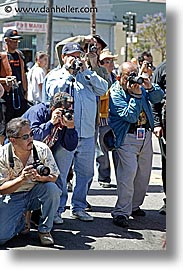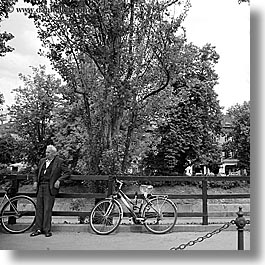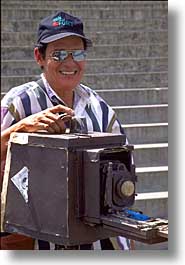|
Markers indicate locations for photos on this page.
Accuracy responsibility of Google Maps
Google Map Goes Here
If you see this text, the map is still loading (or there's an error). |
Back in the late 1990s, the first article I ever wrote about the business of photography was "penned" as a simple response to someone's assertion that the only way for photographers to keep prices from falling was for them to all band together and pledge to one another that they would not undercut or undersell each other. My article argued that this idea was naive, and that basic economic principles (established throughout time) have proven that the best way for photographers to do well is the way any free-market system worked: to allow healthy competition between suppliers. This allows the best performers to rise to the top, and the weakest to die off, keeping the balance of supply and demand in equilibrium. Prices settle where the market dictates based on this equilibrium. That article was named the same as this chapter; I highlighted the five most misunderstood facts about business and phrased it in terms of the photography business. Almost the entire content of that article is contained here, though it's since been updated and expanded to include references to even more resources to substantiate the case further: that the photo industry is no different from any other in the free-market system that isn't protected by legislation: people compete with each other on price, and there's no way to manipulate the system beyond an extremely small number of competitors. As I continued to write, I found myself fighting more false illusions about the photo industry that so-called "pros" were advocating, such as their advice not to put your photos on the web, as they'll just be stolen. I was arguing 180-degrees the other way: put them on the web so you will be found, and people will buy your pictures. Indeed, if it weren't for the enormous push-back I was getting from the established pros at the time, I would have left it at that. But I was forced to prove my theories. So, I put all that advice I was pontificating to work in a real photo business. In very short order, I was turning a very healthy profit. And over time, others who have followed the principles I advocated have reported similar results. This lead to a wider distribution of my articles on the web and other publications. By 2004, my reputation had gotten the attention of two publishers who wished to publish these articles in book form, which had gone on sale in mid-late 2005. While I would love to claim ownership of these ideas and responsibility for making a fundamental change to the history of photography, I can't. I have simply applied the most basic, fundamental business concepts that you can read about in any introductory-level economics course in college. In fact, nothing of what I have ever discussed or applied is "advanced" by any means. As a business, photography isn't like the stock market, where you need complex calculus formulas to derive projections for where market trends may go, or the future prices of commodities. Photography is one of the most basic, quintessential prototypes for how a "small business" works. It's the single-celled creature of the business world, making it the easiest to analyze, experiment with, test, and retest. It's the perfect model for anyone to put into practice—and see results—of the application of introductory-level business ideas.
In the decade that passed since my first writings, the trend of the photo market has shown an undeniable preponderance of evidence to bolster an even more persuasive argument that the free-market system is alive and kicking in the photo world. "Falling stock photography prices" and "increased competition" and the vast numbers of people who are contributing to microstock stock agencies, all point to exactly the very principles of economics that come into play when the free flow of product is in full motion, unimpeded by artificial barriers on the supply side (such as when suppliers choke off distribution channels in order to maintain market prices), or on the production side (such as when unions control compensation through collective bargaining and government support though legislation). When you remove barriers, you get conditions that give definition to the the term, "free-market." And in such conditions, one can't depend on (or expect people to adhere to) behaviors that themselves depend on those very barriers. That is, without government mandate or other artificial controls, it's unrealistic to expect workers to "band together," nor can you expect suppliers to cooperate in price controls (unless the number of suppliers is very small). The only thing you can expect to have is precisely what makes a free-market economy work: competition. Yet, even today, what with all we've learned since the internet has given rise to all sorts of changes in every industry on the planet, all professional photography associations and industry trade magazines still haven't changed their tune about the business models they advocate to their memberships, or "report" in their news analysis in trade journals. They still view the business of photography in the usual way: that it's all about sticking together as a group, or by agreeing not to lower prices (and cursing at those who do). (Again, this is covered in this chapter.) As a historical (and sociological) study, the reasons for this are interesting (and admittedly very understandable), and many lessons can be drawn from it. The first half of this chapter focuses in great detail about the history of how it started this way, and why it was once a good, working model. (Hint: distribution channels were controlled, and photographers had once been a union.) From a sociological point of view, I could never quite understand why they would continue to advocate a model that can't possibly succeed in today's market. Until, that is, I came across this fine quote:
Admittedly, this assumes that the leadership of those organizations actually do know that their messages or teachings are dated, which may not necessarily be the case. After all, they have been so married to their ideals for so long, I certainly don't expect the old guard to be so ready to change their spectacles. In a way, they are seeing only the truth that comforts them. And to perpetuate this truth, one needs a villain, which is not hard to find: the unskilled newcomer who's making money easily in a market that took you years to conquer. There's no more gut-wrenching emotion stronger than the feeling that you've lost your income to a less-skilled, junior photographer who (you feel) only got the job because he was willing to work for less, or (gasp), for free. When your stock photo sales go down because a micro-stock agency is selling images for $1/each, there's another party to blame. When your own agency pays you a smaller and smaller percentage of sales because their own margins are getting squeezed (and their CEO is taking in an annual compensation package that can eliminate starvation in a small African country), there's yet another party to blame. These common occurrences have been powerful rallying cries for leaders and followers alike, who together, can find no fault of their own for their diminishing financial conditions. It's so easy and to blame the "bad photographer" for breaking code and undermining other photographers, or the bad company for looking only to their bottom-line by compromising quality (of images) for simply getting cheaper ones. Leaders and photo industry media pontificate to groups about these things, and pine for the old days, when the photo industry was very different indeed, virtually assuring that their members will hold on and continue to contribute. Indeed, this is the discomfort of the reality of the free-market system, and you can't deny this truth simply because it's uncomfortable. To that, I'm compelled to add another apropos quip:
Above all else, the main purpose of all my writing is to get you to
think critically and analytically about business. Critical thinking is
a discipline that challenges you to examine all sides of any issue or
postulate. Business changes so rapidly, that what was true yesterday
may not be true today, and today's lessons may not apply tomorrow.
As conditions change (market place, pricing, technology, economics),
different decisions should be made based on current circumstances.
Anyone who says, "this is the way the photo business has always worked,
and it always will," is viewing the world too simplistically. All too
often, people react to business conditions by applying preprogrammed
mantras, or by blindly following others. To make sound, intelligent
decisions about how and where to spend capital, to predict what people
will buy and when, to effectively price products or services, and most
of all, to know what do when things go wrong, one needs to see how all of
it fits in the bigger picture without prejudice to how things used to be.
Anyone wishing to enter the photography business as a serious endeavor must recognize that there are two polarized views about this industry's business climate, each offering opposing philosophies on how to approach your business. We will examine each view closely, and ascertain from those strategies which may be more pertinent to today's environment. The two paradigms under consideration are the historical model that has traditionally been part of the photography culture, and the free-market model, where most businesses operate in a capitalist economic system. We'll discuss each in depth, but let's start by defining them in terms of how they apply to the photography industry.
Clearly, since there is no way to force compliance among photographers, or from clients, for that matter, policing the solidarity is also a shared responsibility among those who participate. Uncooperative photographers are "excommunicated" and, on occasion, outed through industry press. The terms of the solidarity—also called "codes of ethics"—are currently written by industry trade groups (made up of the participating photographers), which include subgroups within market segments. Current language for such codes include, "never underbid other photographers," "never bid an assignment below cost," "never work for free," and "never consider your own needs at the expense of the industry."
In the end, the theory goes, photographers only need to compete with one another on one aspect: their craft. All other business terms would have been negotiated in good faith in advance by "the industry" and the majority of the photo-buying clientele. This would reduce incidences of workers being unfairly exploited by the bigger and richer employers or licensees.
The free-market paradigm presumes that photographers compete head to head on everything from price to contract terms to all other aspects of business at every level. As individuals focus on promoting their career as best they can, those who are most successful rise to the top, while the lesser successful photographers drop off (change careers, etc.). In the free-market model, the survival of the fittest strengthens the industry as a whole, and the de-facto leaders become the trend-setters for how business is done. As the business climate changes, as technology or other aspects of the environment change, so too do the photographers, or they drop off, making way for others who are more adept at the new climate.
This model needs no oversight or policing, because the free-market system
is self-sustaining. Buyers who desire valuable photographers and their
assets pay based on demonstrated value at whatever tier of proficiency
they desire for their project, since photographers at all tiers are
available by design. As better and more qualified photographers rise
through merit and strong business acumen, a more stable foundation is
established to secure industry terms. Best of all, the system is flexible
due to changing technological or economic conditions: when such changes
occur, emerging photographers who succeed in the new environment naturally
set the stage for those who follow.
Neither model is new or unique: the solidarity model is used by unions all over the country today, as well as many European countries with strong socialist governments. The "free-market" model is used throughout most non-manufacturing industries in the United States, ranging from technology to medical care. The predicate question in determining which model is more appropriate for photographers in today's market is based on this question:
This begs the corollary question:
An example of this risk analysis is found today with oil producers. Because there are only a few countries that produce and supply oil to the world, they can control pricing by simply cooperating with one another and agreeing not to sell below a certain price. While this form of organized price control is largely effective, it is also brittle, as evidenced by this example: In 1999, the "agreed" price among OPEC members was $28/barrel, but Venezuela was having several economic troubles internally, and the only way they could get out of it was by secretly and quietly dropping its prices to $20/barrel, thereby cornering the market. The lower price was offset by the disproportionate amount of oil they sold (relative to their competitors), hence, yielding a net profit. By the time the news got out, they had already realized the revenue boost they were seeking, whereby they returned to "compliance prices" before getting penalized by the consortium.
If one were to believe that sufficient cooperation can be obtained from the photo industry, then it not only makes sense to participate in this solidarity, but you should be able to build a business strategy that confidently relies on such cooperation. If one does not believe that solidarity is sustainable, one has no choice but to default to a free-market model of competitive strategies against competition because, well, everyone else is.
What makes this question so important—and why so much attention is
given to it in this chapter—is that virtually all professional
photo organizations (commercial and educational) base their entire
business foundations on the Solidarity Model. Their influence on the photo
community is strong, and dissenting views are not widely heard (so you're
not going to see this material in their curricula), so most people who
go through traditional educational programs are going to hear that model,
and no other. This is what is called a "captive audience," where the
members usually don't have other business experiences on which to base
their analysis. That is, emerging photographers look to professionals
for guidance, and there is no other source of information they can
rely on. Moreover, most professionals today evolved from an era when
the Solidarity Model was not only the prevailing one, but it worked. In
order to study the topic objectively, one has to do independent analysis.
We'll start that here by looking first at the historical context.
At the same time, photo agencies, media companies and other conglomerates were able to build a scalable infrastructure, where they could streamline processes, keep costs down, and increase volume, all of which boosts profitability. This profit margin was enhanced by the time factor, since they could deal with hundreds or thousands of clients at a time, making the aggregate turnaround time considerably better for all involved. There were enough of agencies to enable competition, but not enough to lose control of the distribution channel. For this reason alone, most photographers had to either work for a full-time employer, or had to have full-time representation by one or more agencies.
Because magazines and agencies controlled what images to use and where to use them, photographers really had few creative outlets, much less flexibility in their own futures. This caused a backlash among a select group of now-famous luminaries, lead by Henri Cartier-Bresson and Robert Capa. Together, with two other photographers, they founded Magnum in 1947, as the first photographer-owned and operated "co-operative" (agency). The founding principle of this organization was that photographers had their own vision of what they could shoot, and given the latest technology (small cameras), they could go out into the world and capture it in photos. Their assumption—and they were right—was that every magazine would clamor over them. Magnum's success attracted top photographers from all major magazines, which put the agency in control of business terms and other negotiations. This is the critical point here, and is the foundation for how the photo industry views itself today. Magnum became the main go-to repository for news and other life images that were used by newspapers and magazines worldwide for years to come, and they trail blazed the model where the collective had more power than the individual. They proved that by working together as a whole, all photographers could rise higher than they could if they all worked independently.
Indeed, this model persisted for many years. As long as the distribution
channel was in the hands of the few, and as long as the photographers
remained cohesive in their business dealings, there was never a need
to change from this model.
Today, the internet allows high quality pictures to be distributed
directly, instantly, and inexpensively between buyers and sellers
all over the world. As the flood gates opened, the supply of images
skyrocketed, causing swift downward pressure on prices. This immediately
increased the supply of photographers by several orders of magnitude. The
entire market ballooned, but it was the individual photographer who was
quicker and nimbler than his agency counterparts to meet and conform to
the demands of buyers. Furthermore, individuals could do so at lower
prices because of lower overhead. Photographers found it more profitable
to sell directly to buyers at lower prices than what their agencies were
charging. That is, if a magazine used to buy an image from an agency
for $100, the photographer got $40 after "expenses and
commissions." However, on his own, the photographer could charge $50 for
the same image, and end up with more money. The rate for the image in the
open market dropped from $100 to $50. This proves an interesting data
point: In 1990, 90 percent of images were obtained from photo agencies,
compared with 35 percent in 2000. And the trend is continuing. (Keep
this point in mind; it'll come up again later.)
To answer that question, we must look at economic data to examine how many people are selling images, to whom, for how much, and what those trends are. If the only people selling images are pros who are in complete agreement on pricing structures, this may work. However, if the pool of photo sellers includes non-pros who do not cooperate, this can erode the pricing structure. The more non-pros there are, the less stability the structure has.
But, do those surveys reflect current economic activity? If they are based on older models, one might suspect the validity of the data may no longer apply. So, one must examine two factors: who's doing the survey data? And, does that data meet with statistically viable sampling sizes and methods that reflect today's conditions? If stock photo agencies are doing this research, they are not likely going to survey people who are buying and selling from non-agency sources. Why should they, if the results might suggest that their own business models may not be sustainable? Who else is there? Trade associations? Well, they are there to represent traditional pro photographers, who not only pay membership dues, but also sit on the boards of these associations. Another potential source is trade press. Of all photo-related magazines, only one, Photo Disctrict News, actually talks about the business of photography, and this very small publication is entirely financed and run by the trade associations and camera manufacturers. There's no incentive for them to conduct economic surveys outside of this group. Lastly, there are economists who have some financial reason to study the photo industry, and there are none. Since I've been doing research in the photo industry, I have yet to come across any bona fide economist who's studied the photo licensing industry. In fact, part of my business as a photo industry analyst includes advising investors on such matters, because they are also unable to find other economists or industry analysts (that don't have a clear biased towards the well-being of existing, established players).
So, what we're really looking for is determining what that "representative population size" is of photo buyers and sellers. My specific hypothesis is that the majority of buyers and sellers are no longer associated with the industry as it has been traditionally defined, leaving the traditional photo agencies, and even pro photographers themselves, minor players in the overall economic activity of photo sales. (That doesn't mean they don't have business opportunity; it just means the methods of achieving it are different than they used to be.) We can test whether this hypothesis has legs by looking at other industry data. For example, a report on the sales of digital cameras from Digital Photography Review, (http://www.dpreview.com/news/0407/04073002camerasales.asp) indicates that 22.8 million digital cameras will be sold in between 2005 and 2006, a 42 percent jump from 2003. If one of those non-professional amateurs (who isn't currently part of "industry survey data") sells an image to someone, he may not be counted in the survey. But if a million of these people do it only once a year, that could account of hundreds of millions of dollars of economic activity that traditional surveys don't take into account. Taken a step even further, a report on CNBC states that over the course of five years, over 100 million digital cameras of at least eight megapixels or higher will be sold. If only one percent of those buyers sells $1000 worth of photography per year, that's $1 BILLION of sales that isn't accounted for in current survey data. This, because "the industry" doesn't recognize amateurs in their surveying methodologies.
Could there be a similar phenomenon in the photo industry that current statistical data doesn't account for? We see economic activity that the current photo market surveys can't explain. To wit, the revenues agencies report is rising at a much slower rate than the number of magazines, and even less by the rate of ad revenues from those magazines. Consider this report (http://www.bpaww.com/about_bpa/industry_news/WorldOverview3.05.htm) by BPA, which audits media companies. Here, the topic is an overview of the changing world markets for media and advertising as a result of the Internet. Given those numbers, let's ask the question: if the magazines and their advertisers were obtaining images from photo agencies at (at least) the same proportion they always have been, these agencies would be seeing such astronomical growth, that it would dwarf the entire US Technology sector. Why? Because, unlike media companies, ad agencies, and magazine pages, where there are over thousands of competing companies, there are a precious few photo agencies. And if those agencies were getting the same proportion of business from those companies that they used to, all that revenue would ad up to a huge sum of money.
(Note that since this article was written, I've conducted significantly
more research for clients, the most relevant is discussed
here.)
A stock photographer usually derives a large percentage of his income from sales of pictures he's already shot throughout his career. Therefore, he depends on retaining ownership and copyright to the photos he shoots for his future income. If he enters into a work-for-hire agreement, he may get a fixed fee, but he has no future for his business.
A photographer has no interest in getting into the stock photo business, but wants to use the fixed-fee cash payment from a work-for-hire contract to finance his own studio that he'll use for his portraiture business.
There are many issues raised here, and clearly, some of them have merit. First, work-for-hire contracts are found in many areas of the industry, not just stock photography, and many of the hiring agents do not need the copyright ownership they ask for. The industry says to combat this, photographers need to unite and agree not to agree to such terms. The free-market model recognizes that not all photographers can be simplistically bundled together like that, and that many would find it more beneficial to agree to work-for-hire terms, because the nature of their business model accounts for them. Instead of preaching that everyone should agree to collectively reject such terms, the alternative is to better educate photographers on better negotiation techniques that may apply to individualized business objectives.
Given this, to what degree is it possible, let alone effective, to try
to convince members of industry groups to cooperate on a condition like
work-for-hire contracts, that isn't universally accepted as being good
or bad? It's good for some, bad for others. The market-based model says
that veteran photographers who feel their royalties may be vulnerable
to dilution should leverage the intangible value of their seniority
(reliability, skills, etc.) and accept those contracts ahead of the new
photographers who will assuredly take them. Smart veterans will also find
ways to sweeten the deal too. Some might say this is capitulating to
the agencies, but if the trend is inevitable, it's incumbent upon those
who have the most to lose to work harder to retain what they've got.
Whether you believe the Solidarity Model or the Free-market Model
is the more effective for building your career, there are certain
realities about the industry today that you will have to contend
with. I have categorized these realities into a series of axioms
called The Five Truisms of the Photography Business. These are not
proposals, nor are they subject to broad agreement or voluntary consensus,
nor are they terms that you can accept or reject based on your own
business models. They are simply factual statements about how the industry
works. To what degree you incorporate them in your career-planning is
up to you.
Amateurs notwithstanding, consider the number of semi-pros that have tried to get into the industry, but couldn't because their portfolios were rejected by agencies, or because they had no other representation that could move their images. These people are now rushing in, and selling more than the amateurs who don't even care. In fact, many semi-pros sell more than pros because they're playing catch-up, and, unlike the hobbyist, they are serious about the business. So, instead of just selling images, they are accepting assignments under terms that the old pros would never have taken. Both the hobbyist and the semi-professional unambiguously imply this truism:
Whether it's out of ignorance, or because it is a good deal for them, or because they simply have an interest in photography, this is a fact that you cannot change; the law of supply and demand dictates it.
Because of Truism #1, the market has shifted in favor of the buyer, and
one cannot assume that because the client is wealthy, that pay is higher.
How much clients pay is now based more on market rates, not necessarily
their ability to pay. "Market rates" do vary, and finding an appropriate
fee to charge for any given assignment or license fee is admittedly far
more difficult because of the flux in the industry. Clearly, some rates
are higher than others, depending on the specialty of the shoot, or the
specificity of the need. That means that you and I have to do it the hard
way: by negotiating.
It's true that there is a real problem with compensation and other "benefits" eroding from photo contracts; it does need to be addressed. However, there are constructive and destructive ways to go about it. The kinds of reactions noted above are the wrong way to go, and are responsible for more misfortunes than just lost opportunities. Photographers also lose face because their collective efforts fail more often than not to achieve the results they desire. (This is because of Truism #1.) When things don't go well—or not as well as they used to—no one is responsible for this other than yourself. The more constructive solution is to first recognize that you are an independent entity, responsible for your own business interests, and on one else's. One can't succeed in negotiation by simply chanting the mantra, "Just say no," and hoping others fall in line.
If negotiation fails, as will happen from time to time, you move on. If this happens to you so often that you can't get work or income, then you've got other concerns beyond whether the industry is "fair." You either need to improve your negotiation skills, or reset your expectations for your terms.
As the market has gotten more competitive, photographers who are not salaried
staff employees and have to earn money on their own have found it problematic
to earn a living from a single client, or class thereof. Therefore, it's
imperative to diversify revenue sources, branching into unrelated areas.
For example, wedding photographers have a plethora of "people" images
that can not only sell into the wedding niche of the magazine sector,
but also in any outlet that needs people pictures. (So be sure to get
those model releases signed.) Architectural photographers often find
themselves on location with stunning scenery because of the nature of
the client's property. So, in addition to shooting the gig, they pick up
more pictures, and use those images in other business contexts. Sports
photographers, car photographers, just about anyone who has a camera can
shoot things that aren't part of the "assignment" or even part of their
specialty. When you're doing this, you can pick up a lot of new assets,
while the paying client has already footed the bill.
Now consider how the opposite can happen. Many new photographers come into the scene by working for less (or for free) to get their foot in the door, sometimes displacing the previous shooter who used to do that job. I've displaced other photographers this way, and others have done it to me. Those that I've replaced should have moved on with their careers before I got there; and those who've replaced me usually did so with my blessing: It was time for me to move on. (Many times, I just recommend someone to take my place even though the client doesn't want me to leave.) If your career develops properly, you won't get displaced. Your name, reputation, portfolio and general experience will be justification enough for you to choose which jobs you want, and when you want them.
The business world is harsh, and it's part of the package when you choose to become an independent, working photographer. Recognition of these realities will not only help you consider your business objectives more realistically, but should help you think about how you should react to any given situation. I apply these truisms to Photography and Business Sense, after which, it all comes together in Marketing your Photography Business.
Click to recommend this page: |
|

























